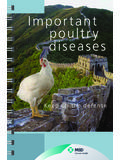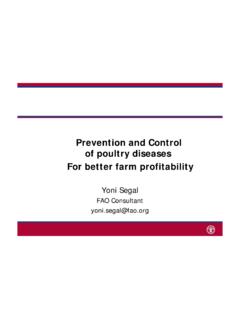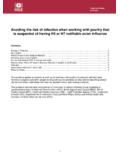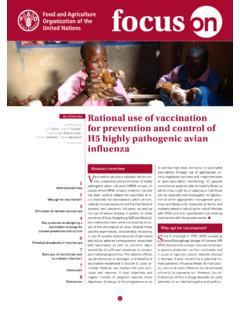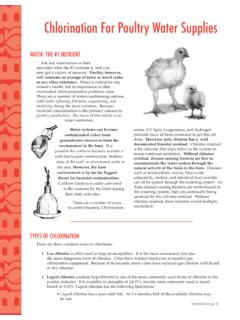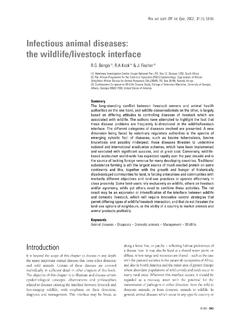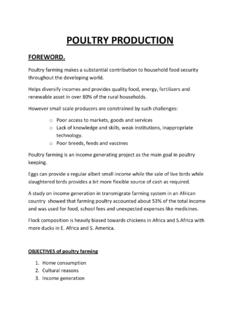Transcription of Important poultry diseases - California Poultry Federation ...
1 ImportantpoultrydiseasesKeep up the defense3 2 Important Poultry DISEASES5 4 Infectious Respiratory diseasesAspergillosis 10 Avain Influenza 12 Avian Metapneumovirus Rhinotracheitis/TRT 14 Infectious Bronchitis 16 Infectious Coryza 20 Infectious Laryngotracheitis 22 Mycoplasma Gallisepticum CRD 27 Mycoplasma Synoviae 30 Newcastle disease 32 Neoplastic DiseasesLymphoid Leucosis 36 Marek s disease 38 Avian Adeno virus DiseasesEgg Drop Syndrome 76 44 Inclusion Body Hepatitis 48 Miscellaneous Viral DiseasesAvian Encephalomyelitis 54 Chicken Anaemia Virus 58 Fowl Pox 60 Infectious Bursal disease 62 Malabsorbtion Syndrome/ Runting Stunting Syndrome 66 Reo virus infections 68 ContentsContentsMiscellaneous Bacterial DiseasesColibacilosis 72 Fowl Cholera 76 Infectious Synovitis 78 Necrotic Enteritis 80 Ornithobacterium Rhinotracheale (OR) 84 Pullorum disease /Fowl Typhoid 86 Parasitic DiseasesBlackhead 90 Coccidiosis 92 Red Mite 96 Worms 98 Deficiency DiseasesRiboflavin 102 VitaminD3 103 VitaminE 104 Food Safety in PoultryIntroduction 106 Salmonellosis 106 Campylobacter 111 Diagnostics and Sampling 1157 6 ForewordForewordForewordThe first edition of Intervet s Important Poultry diseases was in 1972 and still it is one of our most wanted publications.
2 An easy to handle and practical booklet for basic understanding of the most Important Poultry diseases for people working in Poultry is the fifth updated version printed in 2013 with new additional information based on the new developments in Poultry diseases and progress of the MSD Animal Health Poultry Research in developing additional new Animal Health Research is committed to co-operate with the Poultry industry worldwide to develop and support solutions to control Poultry diseases . MSD Animal Health is more than vaccines detailed information of any of our products please contact the local MSD Animal Health representative or Intervet International BV part of MSD Animal International BV Boxmeer- Holland, Box 315830 AA Boxmeer, The NetherlandsPhone +31 485587600 - Fax +31 485577333E-mail - 8 Infectious Respiratory diseasesInfectious Respiratory diseasesInfectious Respiratory diseasest "TQFSHJMMPTJTt "WBJO *OnVFO[Bt "WJBO NFUBQOFVNPWJSVT 3 IJOPUSBDIFJUJT 535t *OGFDUJPVT #SPODIJUJTt *OGFDUJPVT $PSZ[Bt *OGFDUJPVT -BSZOHPUSBDIFJUJTt.]]
3 ZDPQMBTNB (BMMJTFQUJDVN w$3%wt .ZDPQMBTNB 4 ZOPWJBFt /FXDBTUMF %JTFBTF11 10 Infectious Respiratory diseases AspergillosisInfectious Respiratory diseases AspergillosisTreatment and controlThere no specific treatment for infected birds. The best is to remove and destroy a!ected hygiene in breeder (hatching eggs) and hatchery management is necessary. Choice and quality of litter is also Important to prevent that spore bearing wood shavings or straw are control with anti-fungal disinfectant may be critical to cleaning and disinfection procedures to control fungus lesions of the lungsAspergillosis (Fungal Pneumonia)CauseThe principal fungus causing Aspergillosis in Poultry is Aspergillus is by inhalation of fungus spores from contaminated litter ( wood shavings, straw) or contaminated feed. Hatcheries may also contribute to infection of a!ectedYoung chickens are very susceptible.)
4 Older chickens are more resistant to infection. Turkey poults, pheasants, quails, ducklings, and goslings may also become signsInfected chickens are depressed and thirsty. Gasping and rapid breathing can be observed. Mortality is variable, from 5 to 50 %. Gross lesions involve the lungs and airsacs primarily. Yellow-white pin head sized lesions can be found. Sometimes all body cavities are filled with small yellow-green granular fungus presence of Aspergillus fumigatus can be identified microscopically or sometimes even with the naked eye in the air passages of the lungs, in the airsacs or in lesions of the abdominal cavity. Aspergillosis can be confirmed by isolation and identification of the fungus from 12 Infectious Respiratory diseases Avian InfluenzaInfectious Respiratory diseases Avian InfluenzaAvian Influenza (AI)CauseAvian Influenza is caused by an Orthomyxovirus; there are several we know there are 16 H- types and 9 N-types and they can show up in all kinds of combinations.
5 For Poultry the most Important ones are H5, H7 and H9. Pathogenicity varies with the strains HPAI and LPAI (high or low pathogenic AI).TransmissionAI virus is excreted from nares, mouth, conjunctiva and cloaca. Airborne virus particles from the respiratory tract, droppings, and people carrying virus on their clothing and equipment are the main routes of transmission. Migratory water fowl and other wild birds infected with AI virus may be a source of a!ectedAvian Influenza viruses have been shown to naturally infect a wide variety of wild and domestic birds. In Poultry production main problems are in chickens, turkeys and signsClinical signs will vary, depending on the pathogenicity (HPAI and LPAI) of AI virus involved and other factors as host species, sex, concurrent infections, acquired immunity and environmental shows generally mild symptoms: respiratory coughing sneezing, wet eyes, nasal discharge depression, lethargy limited reduction of feed intake and limited drop in egg production; low mortality shows fast onset with increased mortality even before clinical signs are seen, depression, drop in feed and water intake, severe drop in egg production and mortality can vary between 50-90%.
6 DiagnosisClinical signs are indicative for AI; final confirmation by laboratory testing:- Direct detection of AI proteins or Nucleic acids(RNA) using Virus isolation from infected organs, tracheal or cloacal Serology from blood samples after infection and for routine monitoring showing specific AI is no treatment for Avian Influenza. Antibiotics will help to control secondary bacterial and controlIn many countries AI is a notifiable disease with specific local regulations on its AI free areas the disease (LPAI and HPAI) is controlled by monitoring and stamping case of LPAI infected areas countries can decide to allow vaccination only for case of endemic HPAI and/or LPAI vaccination might be is generally done with inactivated AI vaccines based on the strain H-type causing the comb, wattles and legs in a bird affected by 14 Infectious Respiratory diseases Avian MetapneumovirusInfectious Respiratory diseases Avian MetapneumovirusAvian Metapneumovirus (aMPV) Rhinotracheitis (RT) Turkey Rhinotracheitis (TRT) Swollen Head Syndrome (SHS) CauseAvian Metapneumovirus, belongs to the subfamily Pneumovirus from the family Paramyxoviridae.
7 Within the aMPV 4 subtypes (A-B-C-D) are virus spreads horizontally via direct contact from bird to bird and via contaminated personnel, water and a!ectedTurkeys and signs and lesionsIn both turkeys and young birds the respiratory clinical signs; snicking, rales, sneezing, nasal discharge , foamy conjunctivitis, swollen infraorbital and periorbital sinus swollen head are most prominent; when birds become older head shaking and coughing can be added. In adult laying hens there may a drop in egg production up to 70% with an increased incidence of poor shell is general high (up to 100%); mortality varies from up to 50% depending on secondary infections (such as IBV, ) and farm climate conditions. At post mortem the lesions vary. In an uncomplicated infection: rhinitis, tracheitis and sinusitis will dominate , in case of Swollen Head Syndrome, oedema at the head often in combination with purulent or caseous subcutaneous exudate.
8 In complicated cases with polyserositis including fibrinous exudate in abdominal cavity can be signs can give a good indication for aMPV but need to be confirmed by laboratory testing. Identification of virus by isolation or PCR from nasal secretions and/or tracheal or sinus scraping. After infection several serological methods (VN, Elisa, IFT) can be used to detect antibodies. Be aware that vaccines also induce is no treatment for aMPV infections. Treatment with antibiotics can be given to control secondary bacterial is the most e!ective prevention method. Over the years live and inactivated vaccines have been developed and are very e"cacious in controlling infections. Short living birds will only be vaccinated with a live vaccine(s). Long living birds are advised to be primed with live- and boosted with inactivated vaccines. In this way the birds will have good long lasting local and systemic discharge; wet eye17 16 Infectious Respiratory diseases Infectious BronchitisInfectious Respiratory diseases Infectious BronchitisInfectious Bronchitis (IB)CauseInfectious Bronchitis(IB) is present worldwide, it is a highly contagious, acute, and economically Important disease .
9 IB is caused by an Avian Coronavirus. In the field, several di!erent IB serotypes have been identified including the classic Massachusetts type and a number of variants such as IB 4/91, QX, Arkansas and virus is transmitted rapidly from bird to bird through the airborne route. The virus can also be transmitted via the air between chicken houses and even from farm to incubation period is only 1-3 a!ectedChickens are the primary Poultry species that is susceptible to IB-virus, but quail and pheasants can be a! discovery of IB virus in other species without clinical signs indicates that other species may act as signsIn young chickens the respiratory form appears with gasping, sneezing, tracheal rales and nasal discharge. Generally chicks are depressed and show reduced feed consumption. Mortality in general is low unless infection gets complicated with secondary bacterial infections (like ).
10 In case of a nephropathogenic type of IB virus generally birds, after initial respiratory signs, are more depressed, show wet droppings resulting in wet litter, increased water intake and increased adult laying birds (layers and breeders) after initial respiratory signs the a!ected flocks show a drop in egg production and a loss of egg quality (shell deformation and internal egg changes) resulting in more second class eggs, a!ecting the hatchability rate of fertile eggs and day-old chick specific condition, called false layers is related to the QX type of IB; usually flocks do not peak in egg production and many birds show a penguin-like posture .Post mortem lesionsIn young chicks a yellow cheesy plug at the tracheal bifurcation is indicative of IB infection. In case of nephropathogenic infections pale and swollen kidneys and distended ureters with urates are found In older birds mucus and redness in the trachea, exudate in the air sacs, and various changes in the oviduct depending on the time and severity of infection.
